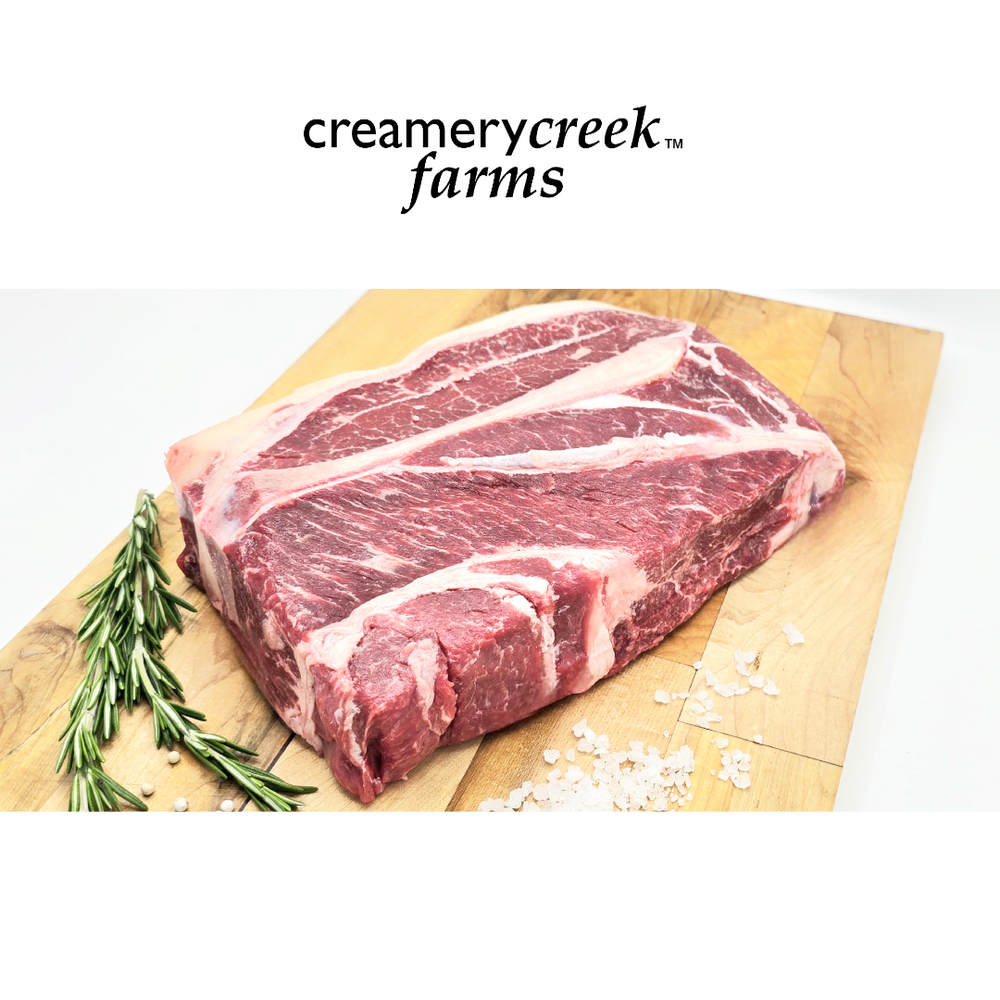
If you’ve ever flipped through a butcher’s case or browsed a farm store online and stumbled on the term “beef roasting joint,” you might have wondered- what exactly does that mean?
It sounds impressive (and it is), but let’s break it down so you know what you’re getting before it hits your dinner table.
First, What is Dry Aged Beef?
Dry aging is a traditional process where whole beef primals are stored in a carefully controlled environment (cold temperature, specific humidity, and constant airflow) for several weeks. Over time, two things happen:
Enzymes naturally tenderize the meat.
Moisture loss concentrates the flavor.
The result? Beef that has a deeper, richer, nuttier taste than fresh-cut meat, with a tenderness that’s hard to beat. At Creamery Creek, for example, we age our beef at least 21 days (sometimes longer for our creekreserve line) to give it that signature flavor and texture.
So What is a “Roasting Joint”?
“Joint” is an old-school term often used in the UK for a cut of meat that’s best suited for roasting. In the U.S., you might hear "roast" instead, think chuck roast, sirloin tip roast, or rib roast. A roasting joint usually refers to a larger, bone-in or boneless cut that’s cooked low and slow in the oven.
When you put the two together, a dry aged beef roasting joint is simply a roast that’s been dry aged before cutting. That means you’re getting all the comfort of a classic Sunday roast with the added luxury of that aged flavor and tenderness.
Why Choose a Dry Aged Roasting Joint?
Roasts have a flavor that stands out - Dry aging intensifies the beefy taste, making a roast feel more like a special occasion meal even if it’s just Tuesday night.
Tender Every Time - The natural enzymes from the aging process mean your knife will glide through slices.
Versatile for Gatherings - Whether you choose a rib roast for a holiday dinner, a sirloin tip roast for weeknight meals, or a chuck roast for pot roast, dry aging adds that “wow” factor.
How to Cook It
A dry aged roasting joint doesn’t require much fuss. Season generously with salt, pepper, and maybe a rub of fresh herbs, then roast in the oven until it reaches your preferred doneness. Since dry aged beef is already packed with flavor, you don’t need heavy sauces or complicated marinades, just let the beef shine.
Takeaway: A dry aged beef roasting joint is simply a roast (like rib, sirloin, or chuck) that’s been aged to develop more flavor and tenderness. It’s comfort food with an upgrade, perfect for both Sunday dinners and holiday celebrations. Just depends on where you live for what it's called!
If you try one, let me know, I'd love to hear all about it!
XOXO,
Louisa



Leave a comment
Also in Farm Family Recipes
The Church Method for Perfect Beef Roasts
There is a whole world of cooking that never made it into cookbooks. It lives in church basements and community halls where somebody’s aunt has been feeding a crowd for decades and never once owned a digital thermometer. The “church basement method” is simple. Multiply the weight of your roast by time, set the oven to a steady low heat, and follow one important rule. Don’t peek.
It works with everyday beef roasts like sirloin tip, chuck, rump, and top round, which means you do not need a prime rib to put something special on the table.
Keep reading
Slow Cooker Meals for Busy Farm Nights
When chores run late and the weather turns cool, nothing beats a slow cooker meal waiting at the end of the day. Here are our favorite Creamery Creek cuts and easy ideas for fall and winter suppers that cook themselves while you work.
Keep reading
Sweet & Tangy Holiday Meatballs (Farmhouse Appetizer Recipe)
There’s always that one dish that disappears first at every holiday party and these little meatballs are it. Made with our own Creamery Creek Meatball Mix (a blend of dry-aged beef, Duroc pork, and just the right touch of onion), this recipe brings that cozy, sweet-and-smoky flavor everyone loves. A quick toss in sweet fruit jam and BBQ sauce blend, a brush under the broiler, and you’ve got the perfect farmhouse appetizer for the season.
Keep reading